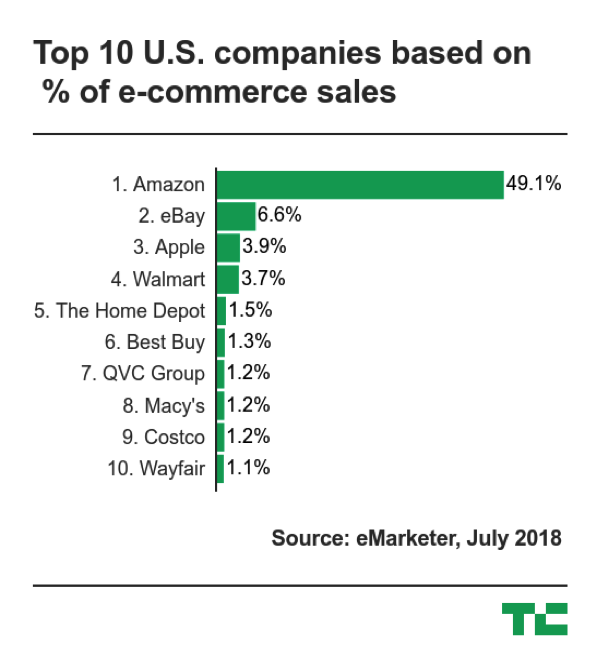Several companies are looking for a way to sell more online. Unfortunately, too many Quebec businesses are lagging behind the very popular trend of online “marketplaces”. Several merchants know Amazon. On the other hand, instead of seeing this platform as an ally in their online sales strategy, they only see it as a competition and lose sales opportunities. This needs to change, and quickly!
According to NETendance2017, a third of Quebecers made a purchase on Amazon in 2017, and these sales represent 15% of all online transactions in the province. It is certain that these statistics increased in favor of Amazon in 2018. Do you see the gap between your current strategy and that of the marketplaces? Chances are, your customers are already Amazon buyers.
If you are targeting the American market, it is even stronger. Last July, Amazon owned 49% of online sales and 5% of the entire US retail sector.
Not to mention, there are over 100,000,000 Amazon Prime subscribers worldwide!

There is a golden rule in commerce: you position your business where people will be able to access the products. Would you position your business at the bottom of an abandoned row? Certainly not. And why? Because no one would have access to it. It’s the same online. Of course, it is important to have your own site, which you can control and which serves to promote your notoriety or to sell to people who know you. And you are surely spending a lot of money on SEO, SEM, digital advertising to attract people to your site! However, you also have to be present and active in marketplaces, and open your Amazon store, even if it means reviewing your strategy.
Tip 1: Be Where your Customers Shop!
People who shop online have become accustomed to looking directly at marketplaces like Amazon before they even "Google" the product they are looking for.
But why?
Amazon has developed the Amazon Prime program, which is one of the best customer retention models in recent years, because it really adds a lot of value to this e-commerce site. If 100,000,000 consumers around the world pay for fast, free shipping, they'll get into the habit of optimizing their spending and going straight to Amazon.
Very few companies are able to compete with the customer experience Amazon offers, both in functionality, product offering, logistics, lead time, delivery and customer service.
Tip 2: If you Can’t Beat Them, Join Them!
What's really dangerous about Amazon is that your potential and current customers are already buying their products there, and that dramatically increases their expectations of retailers who aren't. They are used to the efficiency of the Amazon stores. So they expect your strategy to be just as effective. Good luck!
Instead of collapsing under the pressure of unfulfilled expectations, be active in marketplaces. Consider opening an Amazon store: in addition to being good with consumers, they are also good with retailers.
Amazon has become a titan because the company innovates and changes the consumption habits of a large part of the population! If you work for a well-known brand, you might be telling yourself that Amazon or other marketplaces are not for you. You tell yourself that it's mostly small retailers and brands that are using it to get started.
Unfortunately, this is a myth! You would be wrong to think that big brands shun Amazon ... Here is a list of brands that sell their products on Amazon themselves: Microsoft, Nintendo, Sony, KitchenAid, Cuisinart, Toshiba, Harley Davidson, Reebok, Under Armor, etc. .
Chances are, many of your potential customers are looking for products similar to yours on Amazon (and other marketplaces) and you're not. How does it feel to not even be considered by so many potential clients?
Either way, it needs to motivate you just enough to launch your Amazon store. Better late than never!

Tip 3: Omnichannel is Better than Multichannel
In terms of business strategy, we are no longer talking about choosing between a single platform (single-channel) or several platforms (multi-channel). We are now talking about the choice of retailers between a multi-channel and omnichannel commerce strategy. In both cases, we sell on several platforms. On the other hand, in the case of omnichannel, the channels are not in silos, but well linked together in a concerted global strategy.
And that's what we're trying to convey to you: Using Amazon and other marketplaces is complementary to your efforts to sell on your own website, microsites, social media, and more.
Remember, you need to be present where your active and potential customers are. Considering Amazon and marketplaces is a must in e-commerce.
If you have any questions or e-commerce strategy implementation needs, please let us know. At Globalia, we are experts in e-commerce and marketplaces such as Amazon. We have supported and guided several companies of all sizes and in various fields, B2B and B2C.
In this article, we took a lot of interest in Amazon, but be aware that there are several other interesting “marketplaces” out there (there are more and more that are niched in industries). Besides Amazon, you certainly know some from this list: eBay, Walmart marketplace, Etsy, Wayfair, Houzz, Overstock, Newegg, Jet, Rakuten (formerly Buy.com), AliExpress, etc. Depending on your industry, these sites could allow you to supplement your online points of sale.
Are you convinced? In a future article, we will give you various tips to build your e-commerce strategy on Amazon!




-Jun-06-2024-01-11-23-0147-PM.jpg?width=600&name=Partenaire-Google%20(1)-Jun-06-2024-01-11-23-0147-PM.jpg)
.png?width=1379&name=Aspect%20(1).png)